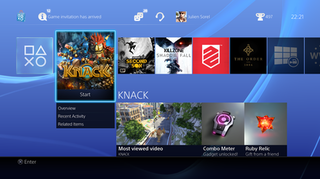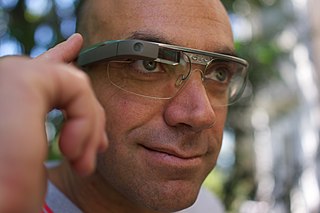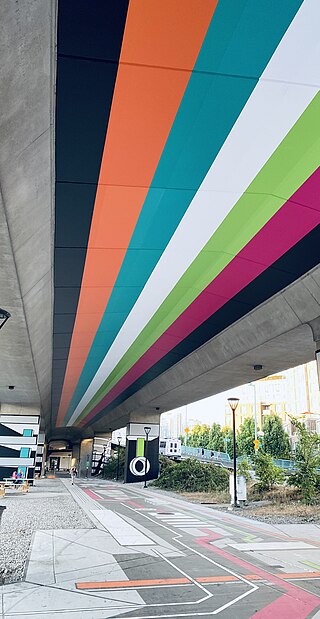Related Research Articles

Augmented reality (AR) is an interactive experience that combines the real world and computer-generated content. The content can span multiple sensory modalities, including visual, auditory, haptic, somatosensory and olfactory. AR can be defined as a system that incorporates three basic features: a combination of real and virtual worlds, real-time interaction, and accurate 3D registration of virtual and real objects. The overlaid sensory information can be constructive, or destructive. This experience is seamlessly interwoven with the physical world such that it is perceived as an immersive aspect of the real environment. In this way, augmented reality alters one's ongoing perception of a real-world environment, whereas virtual reality completely replaces the user's real-world environment with a simulated one.

A smartphone is a portable computer device that combines mobile telephone functions and computing functions into one unit. They are distinguished from older-design feature phones by their stronger hardware capabilities and extensive mobile operating systems, which facilitate wider software, access to the internet, and multimedia functionality, alongside core phone functions such as voice calls and text messaging. Smartphones typically contain a number of metal–oxide–semiconductor (MOS) integrated circuit (IC) chips, include various sensors that can be leveraged by pre-installed and third-party software, and support wireless communication protocols. More recently, smartphone manufacturers have begun to integrate satellite messaging connectivity and satellite emergency services into devices for use in remote regions where there is no reliable cellular network.

A mobile device is a computer small enough to hold and operate in the hand. Mobile devices typically have a flat LCD or OLED screen, a touchscreen interface, and digital or physical buttons. They may also have a physical keyboard. Many such devices can connect to the Internet and connect with other devices such as car entertainment systems or headsets via Wi-Fi, Bluetooth, cellular networks or near field communication. Integrated cameras, the ability to place and receive voice and video telephone calls, video games, and Global Positioning System (GPS) capabilities are common. Power is typically provided by a lithium-ion battery. Mobile devices may run mobile operating systems that allow third-party applications to be installed and run.

Mixed reality (MR) is a term used to describe the merging of a real-world environment and a computer-generated one. Physical and virtual objects may co-exist in mixed reality environments and interact in real time.

Interactive media normally refers to products and services on digital computer-based systems which respond to the user's actions by presenting content such as text, moving image, animation, video and audio. Since its early conception, various forms of interactive media have emerged with impacts on educational and commercial markets. With the rise of decision-driven media, concerns surround the impacts of cybersecurity and societal distraction.

Digital signage is a segment of electronic signage. Digital displays use technologies such as LCD, LED, projection and e-paper to display digital images, video, web pages, weather data, restaurant menus, or text. They can be found in public spaces, transportation systems, museums, stadiums, retail stores, hotels, restaurants and corporate buildings etc., to provide wayfinding, exhibitions, marketing and outdoor advertising. They are used as a network of electronic displays that are centrally managed and individually addressable for the display of text, animated or video messages for advertising, information, entertainment and merchandising to targeted audiences.

Mobile technology is the technology used for cellular communication. Mobile technology has evolved rapidly over the past few years. Since the start of this millennium, a standard mobile device has gone from being no more than a simple two-way pager to being a mobile phone, GPS navigation device, an embedded web browser and instant messaging client, and a handheld gaming console. Many experts believe that the future of computer technology rests in mobile computing with wireless networking. Mobile computing by way of tablet computers is becoming more popular. Tablets are available on the 3G and 4G networks. Mobile technology has different meanings in different aspects, mainly mobile technology in information technology and mobile technology in basketball technology, mainly based on the wireless technology of wireless devices equipment information technology integration.
A smart TV, also known as a connected TV (CTV), is a traditional television set with integrated Internet and interactive Web 2.0 features, which allows users to stream music and videos, browse the internet, and view photos. Smart TVs are a technological convergence of computers, televisions, and digital media players. Besides the traditional functions of television sets provided through traditional broadcasting media, these devices can provide access to over-the-top media services such as streaming television and internet radio, along with home networking access.

Kia Silverbrook is an Australian independent inventor and scientist. He is one of the most prolific inventors in the world, and has been granted 4,747 US utility patents as of 14 February 2022. Internationally, he has 9,874 patents or patent applications registered at the international patent document database (INPADOC). Silverbrook has founded companies and developed products in a wide range of disciplines, including computer graphics, video and audio production, scientific computing, factory automation, digital printing, liquid crystal displays (LCDs), molecular electronics, internet software, content management, genetic analysis, MEMS devices, security inks, photovoltaic solar cells, and interactive paper.

Word Lens was an augmented reality translation application from Quest Visual. Word Lens used the built-in cameras on smartphones and similar devices to quickly scan and identify foreign text, and then translated and displayed the words in another language on the device's display. The words were displayed in the original context on the original background, and the translation was performed in real-time without a connection to the internet. For example, using the viewfinder of a camera to show a shop sign on a smartphone's display would result in a real-time image of the shop sign being displayed, but the words shown on the sign would be the translated words instead of the original foreign words.
Vuzix is an American multinational technology company headquartered in Rochester, New York. Founded in 1997 by Paul Travers, Vuzix is a supplier of wearable display technology, virtual reality, and augmented reality. Vuzix manufactures and sells computer display devices and software. Vuzix personal display devices are used for mobile and immersive augmented reality applications, such as 3D gaming, manufacturing training, and military tactical equipment. On January 5, 2015, Intel acquired 30% of Vuzix's stock for $24.8 million.
David M. Granger is an American journalist. He was editor-in-chief of Esquire Magazine from June 1997 until March 2016. Granger is a literary agent and media consultant working with Aevitas Creative Management.
WebAR, previously known as the Augmented Web, is a web technology that allows for augmented reality functionality within a web browser. It is a combination of HTML5, Web Audio, WebGL, and WebRTC. From 2020s more known as web-based Augmented Reality or WebAR, which is about the use of augmented reality elements in browsers.

Screen-Smart Device Interaction (SSI) is fairly new technology developed as a sub-branch of Digital Signage.

The PlayStation 4 system software is the updatable firmware and operating system of the PlayStation 4. The operating system is Orbis OS, based on FreeBSD 9.

Augment is an augmented reality SaaS platform that allows users to visualize their products in 3D in real environment and in real-time through tablets or smartphones. The software can be used for retail, e-commerce, architecture, and other purposes.

Smartglasses or smart glasses are eye or head-worn wearable computers that offer useful capabilities to the user. Many smartglasses include displays that add information alongside or to what the wearer sees. Alternatively, smartglasses are sometimes defined as glasses that are able to change their optical properties, such as smart sunglasses that are programmed to change tint by electronic means.

Kubity is a cloud-based 3D communication tool that works on desktop computers, the web, smartphones, tablets, augmented reality gear, and virtual reality glasses. Kubity is powered by several proprietary 3D processing engines including "Paragone" and "Etna" that prepare the 3D file for transfer over mobile devices.
Commercial augmented reality (CAR) describes augmented reality (AR) applications that support various B2B (Business-to-Business) and B2C (Business-to-Consumer) commercial activities, particularly for the retail industry. The use of CAR started in 2010 with virtual dressing rooms for E-commerce.

Voxel Bridge is an interactive public artwork under the Cambie Bridge in Vancouver, by artist Jessica Angel. The 8,000-square-foot (740 m2) mural is a vinyl overlay on the bridge that reveals interactive elements through augmented reality (AR), with aspects of the artwork being sold as non-fungible tokens. The installation will be part of the Vancouver Biennale from summer 2021 to 2023.
References
- ↑ Hagey, Keach. "Esquire To Make Print Magazine Interactive Through Netpage App". Wall Street Journal. Retrieved 8 January 2013.
- ↑ Ward, David. "Netpage's Digital Twin could be a boost for printed magazines". PrintWeek. Archived from the original on 24 December 2012. Retrieved 8 January 2013.
- ↑ Netpage video interview on WSJ Live
- ↑ Netpage article on Mashable